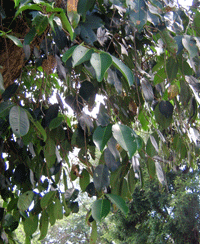
Akasia | Angsana | Asam Jawa | Jambu Laut | Jemerlang | Ketapang | Mambu | Mempari | Pukul Lima | Sentang

INTRODUCTION
Eugenia is a large group of plants, some native
and some non-native, including evergreen trees and
shrubs, some of which have been reclassified to the
genus Syzygium (Fig. 1). The evergreen leaves are
firm and glossy, and the flowers white. It is the dried
buds of Eugenia aromatica (Syzygium aromaticum)
which become the fragrant "herb" cloves. The flowers
are followed by the production of berries, some types
of which are edible. All these traits - the attractive
foliage, flowers, and berries - help make Eugenia a
popular landscape choice in warm climate areas, such
as California, Florida, and Hawaii. Eugenia confusa
(Ironwood, Red Stopper) is native to Florida and
grows to about 35 feet and is well suited for street tree
and parking lot planting. Eugenia foetida (Spanish
Stopper) is also native and grows to about 15 feet tall.
GENERAL INFORMATION
Scientific name: Eugenia spp.
Pronunciation: yoo-JEE-nee-uh species
Common name(s): Stopper, Eugenia
Family: Myrtaceae
USDA hardiness zones: 10B through 11 (Fig. 2)
Origin: native to North America
Uses: container or above-ground planter; hedge; large
parking lot islands (> 200 square feet in size); wide
tree lawns (>6 feet wide); medium-sized parking lot
islands (100-200 square feet in size); medium-sized
tree lawns (4-6 feet wide); recommended for buffer
strips around parking lots or for median strip plantings
in the highway; near a deck or patio; reclamation
plant; screen; trainable as a standard; shade tree;
narrow tree lawns (3-4 feet wide); specimen; sidewalk
cutout (tree pit); residential street tree; no proven
urban tolerance
Availability: generally available in many areas within
its hardiness range
Flower
Flower color: white
Flower characteristics: inconspicuous and not
showy; spring flowering; summer flowering
Fruit
Fruit shape: round
Fruit length: .5 to 1 inch
Fruit covering: fleshy
Fruit color: black; red
Fruit characteristics: attracts birds; attracts squirrels
and other mammals; suited for human consumption; fruit, twigs, or foliage cause significant litter; showy
USE AND MANAGEMENT
The smooth, brown to grey, mottled bark and tight
canopy of fine-textured leaves makes Eugenia well
suited for planting as a specimen in any yard. Trees
can be trained in the nursery to one central trunk or
allowed and encouraged to develop multiple trunks.
They create shade for a patio or deck, but will not
grow to the large, often overpowering size of a Ficus
tree. They are often used along streets, in highway
medians and in parking lots because they adapt to
small soil spaces and do not become very large. Street
and parking lot trees are often specified to have one
trunk to allow for vehicle clearance beneath the crown.
Multiple trunked trees are often specified for specimen
planting so the beautiful bark can be displayed.
Eugenia should be grown in full sun or part shade on well-drained soil. Once established in the landscape, they are drought tolerant requiring little, if any, irrigation.
Propagation is by seeds or cuttings.
